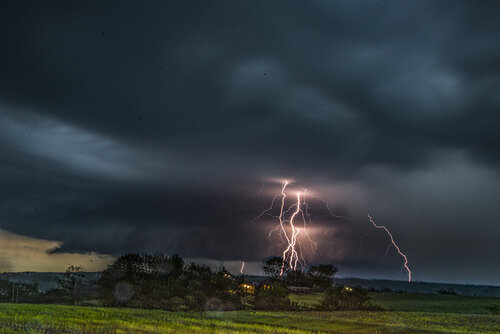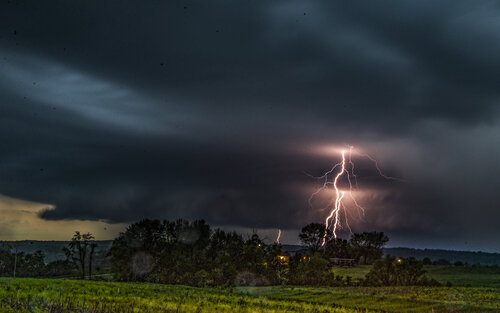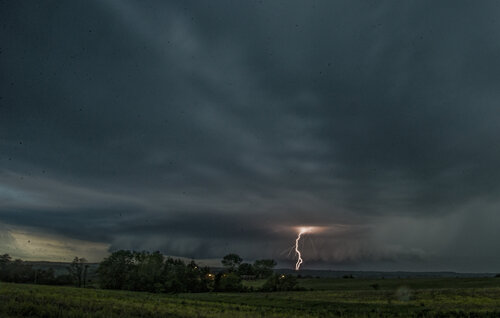Quincy Vagell
EF4
I had a bit of a delayed departure from Oklahoma City. My general target was the Texas Panhandle, but I purposely waited to leave, so that I would have a good idea of exactly where to target by the time I got out there. I left around 9:30 and that put me into the panhandle around lunchtime.
I reviewed data in the morning and noticed that the low-level jet was rather weak looking across the northern half of the target. By late morning, it was clear that convective initiation was imminent. That combined with weak and veering winds in the 1-3km layer, roughly north of I-40, lead me to opt for the southern target. (not Fort Stockton south, but south of Amarillo)
As I dropped south from Claude, I noticed that a relatively discrete storm was intensifying and moving toward Plainview. I got into position, but it seemed to be outflow dominant. I got gas and waited a bit and then noticed a line/cluster of storms forming to the west. These storms quickly showed signs of broad rotation, but something didn't look quite right. I had a visual on one storm that was clearly organizing, but I'm assuming that relatively weak low-level shear did not allow the storm (near Littlefield) to wrap up. The cloud bases were very grungy and ill-defined, compared to what I've encountered with most tornadic supercells.
Right behind that storm, a new semi-discrete cell just south of Littlefield started to get a more classic look., It appears that some sort of boundary was laid down, along a SW-NE axis, near and just north of Lubbock. Several storms fired near that area and almost all of them showed at least transient supercellular characteristics through the afternoon.
I stayed with the storm and even though I didn't have a clear visual on anything right away, the cloud bases were quite low and it looked like an appendage on radar was attempting to interact with a boundary. The storm briefly rooted on the boundary and I observed what initially looked like a funnel cloud for about 1-2 minutes, from 4:59 until about 5:01 p.m. Upon closer examination, I'm pretty sure this was a brief tornado, although I did not conclusively see the funnel touch the ground.
There were at least two or possibly three brief reports of tornadoes in the general area between shortly before 5 and about 7 p.m. Based on radar data, these storms were more outflow-dominant than anything and the spin-ups were driven by boundary interaction, rather than more classic supercellular tornado development. The storms had little to no discernible structure.
Looking back, even into late afternoon when these funnel/brief tornado reports came out, low-level shear was still on the marginal end for tornadoes. It did not help matters that storms developed so early and by the time the low-level jet did ramp up, there was an extensive MCS in progress across Oklahoma/Texas.
One of the aspects of this chase that made me uneasy was just how bad the flooding situation was in and around Lubbock. I know they are prone to flooding, but just about every dirt road I encountered was impassable. Many segments of the I-27 service roads were under water and other paved roads were also blocked due to high water.
As we continue through this active severe weather stretch, there is a lot of real estate from the southern High Plains into Oklahoma and central/southern Kansas that is experiencing significant and locally historic flooding. It makes chasing an already tough pattern even more difficult, but also potentially dangerous.
I reviewed data in the morning and noticed that the low-level jet was rather weak looking across the northern half of the target. By late morning, it was clear that convective initiation was imminent. That combined with weak and veering winds in the 1-3km layer, roughly north of I-40, lead me to opt for the southern target. (not Fort Stockton south, but south of Amarillo)
As I dropped south from Claude, I noticed that a relatively discrete storm was intensifying and moving toward Plainview. I got into position, but it seemed to be outflow dominant. I got gas and waited a bit and then noticed a line/cluster of storms forming to the west. These storms quickly showed signs of broad rotation, but something didn't look quite right. I had a visual on one storm that was clearly organizing, but I'm assuming that relatively weak low-level shear did not allow the storm (near Littlefield) to wrap up. The cloud bases were very grungy and ill-defined, compared to what I've encountered with most tornadic supercells.
Right behind that storm, a new semi-discrete cell just south of Littlefield started to get a more classic look., It appears that some sort of boundary was laid down, along a SW-NE axis, near and just north of Lubbock. Several storms fired near that area and almost all of them showed at least transient supercellular characteristics through the afternoon.
I stayed with the storm and even though I didn't have a clear visual on anything right away, the cloud bases were quite low and it looked like an appendage on radar was attempting to interact with a boundary. The storm briefly rooted on the boundary and I observed what initially looked like a funnel cloud for about 1-2 minutes, from 4:59 until about 5:01 p.m. Upon closer examination, I'm pretty sure this was a brief tornado, although I did not conclusively see the funnel touch the ground.
There were at least two or possibly three brief reports of tornadoes in the general area between shortly before 5 and about 7 p.m. Based on radar data, these storms were more outflow-dominant than anything and the spin-ups were driven by boundary interaction, rather than more classic supercellular tornado development. The storms had little to no discernible structure.
Looking back, even into late afternoon when these funnel/brief tornado reports came out, low-level shear was still on the marginal end for tornadoes. It did not help matters that storms developed so early and by the time the low-level jet did ramp up, there was an extensive MCS in progress across Oklahoma/Texas.
One of the aspects of this chase that made me uneasy was just how bad the flooding situation was in and around Lubbock. I know they are prone to flooding, but just about every dirt road I encountered was impassable. Many segments of the I-27 service roads were under water and other paved roads were also blocked due to high water.
As we continue through this active severe weather stretch, there is a lot of real estate from the southern High Plains into Oklahoma and central/southern Kansas that is experiencing significant and locally historic flooding. It makes chasing an already tough pattern even more difficult, but also potentially dangerous.
Last edited:




